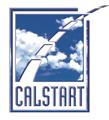By Dr. Cristiano Façanha, Peter Jenkins, and Owen MacDonnell
2020 is coming to a close (thank goodness!). As we work together to pull struggling families, healthcare workers, small businesses and our global economy out of the craterous hole COVID has forged, we recognize the climate and air quality challenges we faced in a pre-covid world are just as urgent in a post-covid world. Despite the obstacles we incurred this year, Drive to Zero’s program and campaign identified and built a number of strategic paths forward and counted several wins on the global stage.
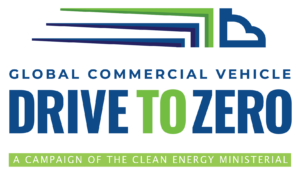
We were honored to be officially welcomed as a new campaign of the Clean Energy Ministerial (CEM) as a part of its Electric Vehicles Initiative (EVI) in September at CEM11, CEM’s 11th annual meeting. Drive to Zero’s new designation as a CEM campaign creates multiple opportunities for global collaboration between governments and the private sector. CEM includes over 25 countries and the European Commission representing roughly 90 percent of global clean energy investments and 75 percent of global greenhouse gas emissions. CEM campaigns are designed to raise visibility and target global resources to those campaigns that have a strong potential for transformative impact in the clean technology sector.
In 2019, we welcomed our first national pledge partner – Canada – and in 2020 also at CEM11, we expanded our list of national pledge partners manyfold by adding China, Chile, Finland, Germany, Japan, Netherlands, Norway and Sweden to our team. Along with these national partners, Drive to Zero has seen steady growth in the number of organizations that have signed the Drive to Zero Pledge, committing to work together to accelerate early markets for zero-emission trucks, buses, and equipment. Our global pledge partners now number more than 100 strong, including leading manufacturers, fleets, governments, infrastructure providers, and other innovators. This groundswell of support – under the auspices of Drive to Zero – came in the wake of a number of new initiatives aimed at putting more zero-emission trucks, buses and other commercial vehicles on the road.
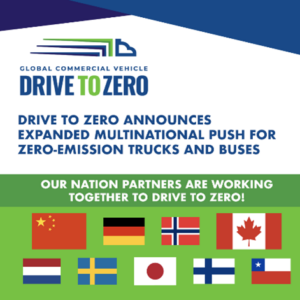
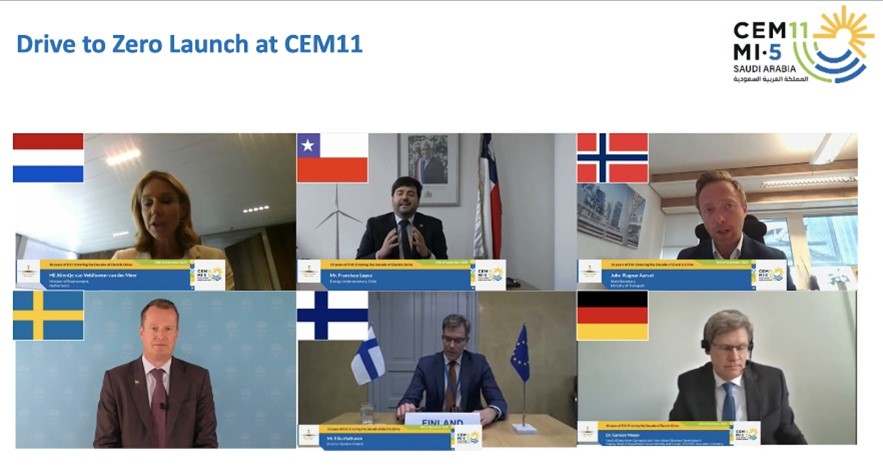
In the United States in June, the California Air Resources Board, an influential sub-national Drive to Zero partner, adopted the landmark Advanced Clean Trucks rule, or ACT. ACT calls on commercial truck and van manufacturers to begin selling zero-emission vehicles by 2024 in California. Under the ambitious policy, all new commercial trucks and vans sold in the state must be zero-emissions by 2045.
Shortly after ACT’s adoption, governors from 15 states – California, Colorado, Connecticut, Hawaii, Maine, Maryland, Massachusetts, New Jersey, New York, North Carolina, Oregon, Pennsylvania, Rhode Island, Vermont and Washington – and the District of Columbia agreed to collaboratively develop strategies to build strong markets for zero-emission commercial vehicles. Additionally, the governments agreed to make sales of all new medium- and heavy-duty vehicles zero-emission vehicles by 2050 with an interim 30 percent zero-emission sales target by 2030. At NYC Climate Week, we partnered with Ceres to examine how the Northeast could become a leading region in the US in light of the Multi-State Truck and Bus MOU.
In the hopes of expanding the reach of the US trucks and buses MOU, Drive to Zero supported the launch of a new global push to reach 100 percent new zero-emission truck and bus sales by 2050 (also with an interim target of 30 percent sales by 2030), with potentially more ambitious targets. The new Global Memorandum of Understanding (MOU) was unveiled by The Transport Decarbonisation Alliance (TDA) at a virtual En Route to COP26 event in partnership with Drive to Zero. Between now and the United Nations Framework Convention on Climate Change Conference of the Parties (COP26) in Glasgow in November 2021, Drive to Zero and the Netherlands as TDA Chair, will work collaboratively to gain as many signatory nations as possible. These nations will work collaboratively toward the 2030 and 2050 sales goals under the auspices of Drive to Zero and TDA.
We know these targets are ambitious, and we also know they are attainable. Drive to Zero is tracking the development of the global zero-emission commercial market and we have shown that vehicle manufacturing and new model development are at the precipice of a major surge. In March, we launched the Zero-Emission Technology Inventory (ZETI), a first-of-its-kind tool and platform for cataloging current and forthcoming zero-emission commercial trucks, buses and off-road equipment. According to ZETI, the number of available and/or announced models of zero-emission trucks, buses and off-road equipment in the United States, Canada, and Europe is on track to rise nearly 42 percent by the end of 2020 compared to year-end 2019 (from 214 to 305 models). That figure is expected to continue to increase by 2023 with OEMs constantly announcing new models.
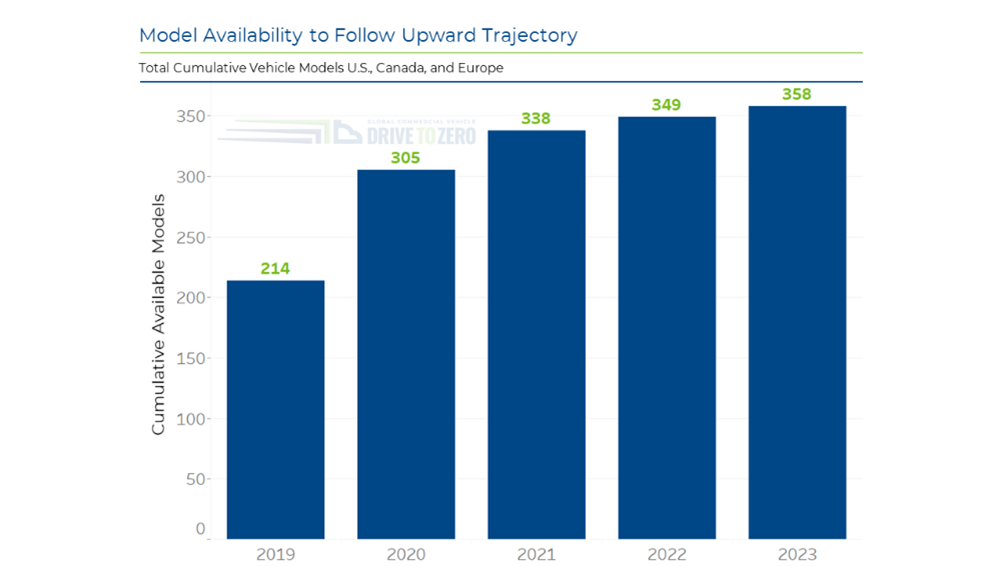
Since its launch in March, ZETI has had an enthusiastic reception amongst industry stakeholders, and the Drive to Zero team continues to update and expand the tool. Summary Statistics and graphs from the ZETI data can be found in ZETI Analytics with accompanying insights and projections. The latest ZETI data highlights the volume of vehicle models and OEMs entering the market and emphasizes the rapidly increasing range available in the market. Consistent with Drive to Zero’s “beachhead strategy” for market change and development, ZETI finds that transit buses are a first success market. This is due to their shorter duty cycles and fixed route service, making charging easier when compared to other applications. Medium-duty zero-emission truck availability in North America is on the fastest growth timeline. This trend is largely due to upfit manufacturers. Heavy-duty zero-emission trucks show consistent growth through 2023.
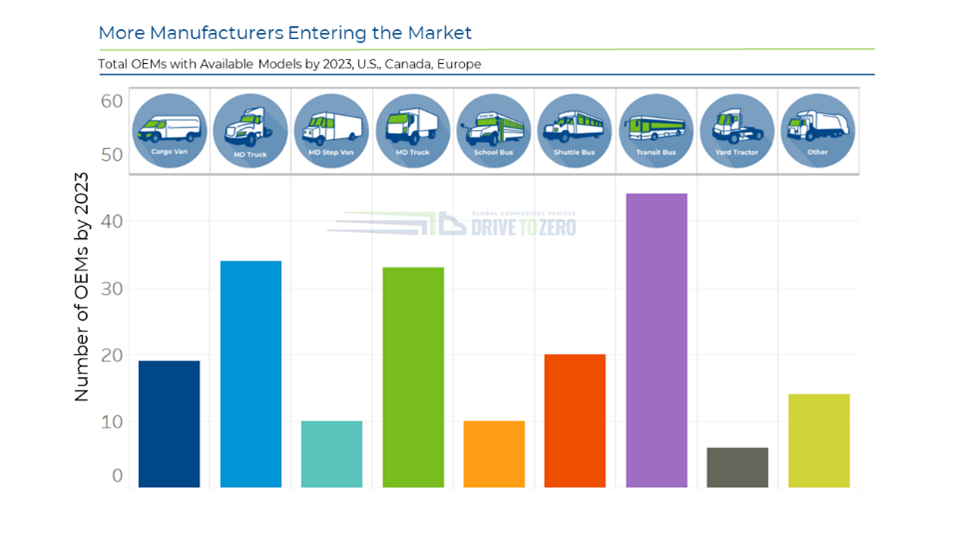
All of these new zero-emission vehicle offerings seem to be hitting the market at just the right time – as the world experiences an unprecedented boom in e-commerce. With the growth in e-commerce deliveries comes the concern about increasing emissions and air pollution from delivery vehicles. Drive to Zero convened stakeholders to examine this issue, and other key opportunities for zero-emission vehicles, during several major events. In partnership with the Transport Decarbonisation Alliance and the Climate Group/EV100, we hosted global clean transportation leaders Volvo Group, UPS, BYD, DHL, Mahindra & Mahindra, the European Clean Trucking Alliance, Kenworth Truck Company, DB Schenker, Flipkart, Euler Motors and many others to examine how North America, Europe and India can speed the Drive to Zero by getting zero-emission delivery vans and trucks on the road.
At GreenBiz’s VERGE 20, Drive to Zero convened innovation leaders from IKEA’s Ingka Group, FedEx, the Clean Off-Road Equipment Voucher Incentive Project (CORE), the NY Green Bank and NextEra Energy. These fleet, finance and clean energy leaders discussed collaboration and partnership opportunities as well as innovative financing tools to accelerate adoption, as well as mechanisms to speed manufacturing and zero-emission commercial vehicle model proliferation.
Along with these new tools and events, Drive to Zero published several studies examining mechanisms to accelerate zero emission commercial vehicle deployment, and equipping stakeholders with a better understanding of how to tackle the challenge ahead.
- Moving Zero-Emission Freight Toward Commercialization examines the zero-emission freight sector from all angles and concludes that zero-emission freight vehicles (ZEFVs) are rapidly emerging to become competitive in a broad spectrum of applications with each of the modeled ZEFV segments expected to achieve cost parity with diesel-powered vehicles by 2030. The report further concludes that strategic combinations of regulations and incentives in leading markets will make operating ZEFVs easier compared to diesel-powered vehicles.
- Voucher Incentive Programs: A Tool for Clean Commercial Vehicle Deployment finds that investments and innovations in clean buses and trucks are progressing at a rapid pace globally. It further finds that fleet adoption of alternative fuel vehicles is hampered by the comparatively high sticker price and that new policy tools (check out our updated Policies and Actions Toolkit) and programs can help facilitate adoption.
- The Beachhead Model – Catalyzing Mass-Market Opportunities for Zero-Emission Commercial Vehicles describes the Drive to Zero “beachhead model” to accelerate the zero-emission commercial vehicle market.
As we turn our vision to 2021 (or as we call it “T minus 29 years to zero”), we want to thank and acknowledge the strategic work of our pledge and implementation partners. Together, we know that we can chart a course to zero – one that delivers climate and clean air benefits, along with a stronger, more resilient economy for all.
